This time around, May’s election will have the Mayoral race at the top of the ballot, and City Council races. Odd-year primaries also bring Philadelphia’s lesser-followed judicial elections. These elections are problematic: we vote for multiple candidates each election, upwards of 7, and even the most educated voter really doesn’t know anything about any of them. In these low-information elections, the most important factor in getting elected is whether a candidate ends up in the first column of the ballot. Ballot position is decided by a lottery. Philadelphia elects its judges at random.
I’ve looked into this before, measuring the impact of ballot position on the Court of Common Pleas, and then that impact by neighborhood. We even ran an experiment to see if we could improve the impact of the Philadelphia Bar’s Recommendations. But first, let’s revisit the story, update it with 2017 results, and establish the gruesome baseline.
The Court of Common Pleas
The most egregious race is for the city’s Court of Common Pleas. That court is responsible for major civil and criminal trials, juvenile and domestic relations, and orphans, so the bulk of our judicial cases. Common Pleas judges are elected to 10-year terms.
The field for Common Pleas is huge; we don’t know how many openings there will be this year, but in the five elections since 2009, there was an average of 31 candidates competing for 9 openings. Even the most informed voter doesn’t know the name of most of these candidates when she enters the voting booth, and ends up either relying on others’ recommendations or voting at random. This is exactly the type of election where other factors–flyers handed out in front of a polling place, the order of names on the ballot–will dominate.
Because of this low attention, some of the judges that do end up winning come with serious allegations against them. In 2015, Scott Diclaudio won; months later he would be censured for misconduct and negligence, and then get caught having given illegal donations in the DA Seth Williams probe. The 2015 race also elected Judge Lyris Younge, who has since been removed from Family Court for violating family rights, and just in October made headlines by evicting a full building of residents with less than a week’s notice. In 2016, Mark Cohen was voted out as state rep after reports on his excessive use of per-diem expenses. In 2017, he was elected to the Court of Common Pleas.
Every one of those candidates—Diclaudio, Younge, and Cohen—was in the first column of the ballot.
Random luck is more important than Democratic Endorsement or Quality
The order of names on the ballot is entirely random, so this gives us a rare chance to causally estimate the importance of order, compared to other factors.
First, what do I mean by ballot order? Here’s a picture of the 2017 Democratic ballot for the Court of Common Pleas.
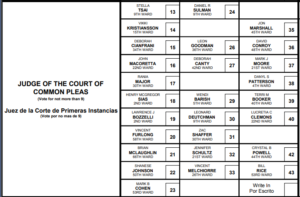
The shape of the ballot changes wildly over years. Sometimes it’s short and wide, in 2017 it was tall and thin. But in every year, candidates in the first column fare better than others. The results year over year show that the first column consistently receives more votes:
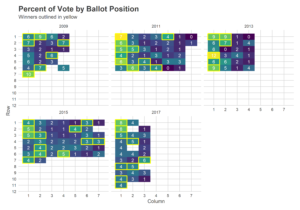
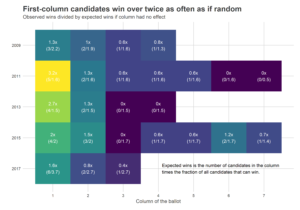
In short, it’s worrisome when Not Recommended candidates win. But win they do. In the last two elections, a total of six Not Recommended candidates won. They were all from the first column.
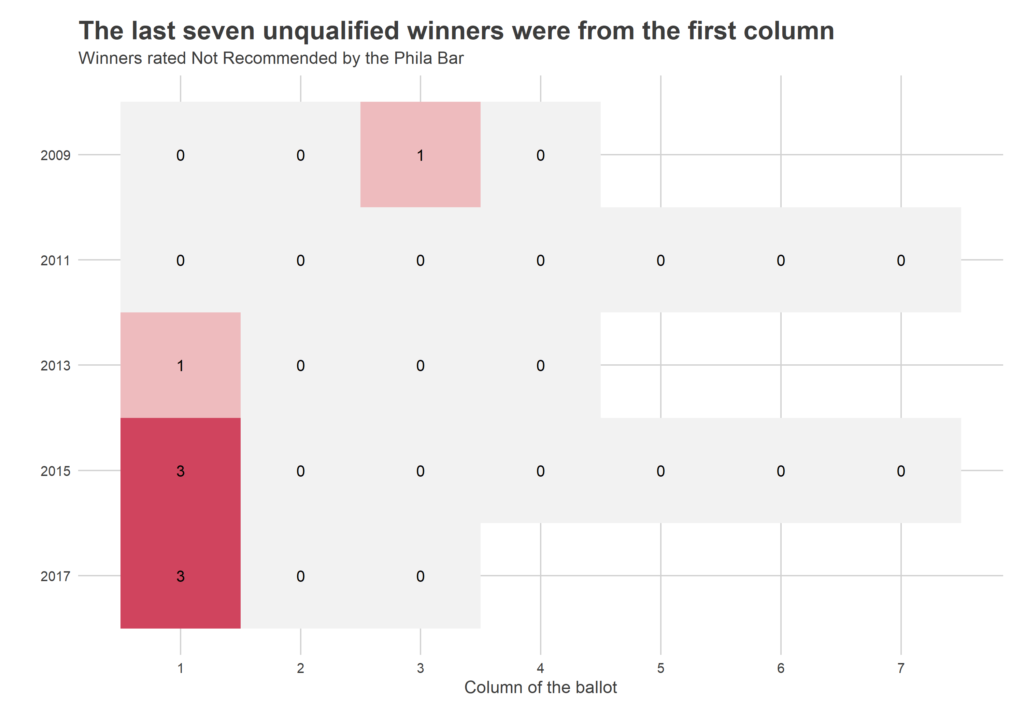
But clearly other factors affect who wins, too. How does the strength of ballot position compare to those others?
Let’s compare the strength of ballot position to three other explanatory features: endorsement by the Democratic City Committee, recommendation by the Philadelphia Bar Association, and endorsement by the Philadelphia Inquirer. (There are two other obvious ones, Ward-level endorsements and money spent. I don’t currently have data on that, but maybe I’ll get around to it!)
I regress the log of each candidate’s total votes on their ballot position (being in the first, second, or third column, versus later ones, and being in the first or second row), endorsements from the Democratic City Committee and the Inquirer, and Recommendation by the Philadelphia Bar, using year fixed effects.
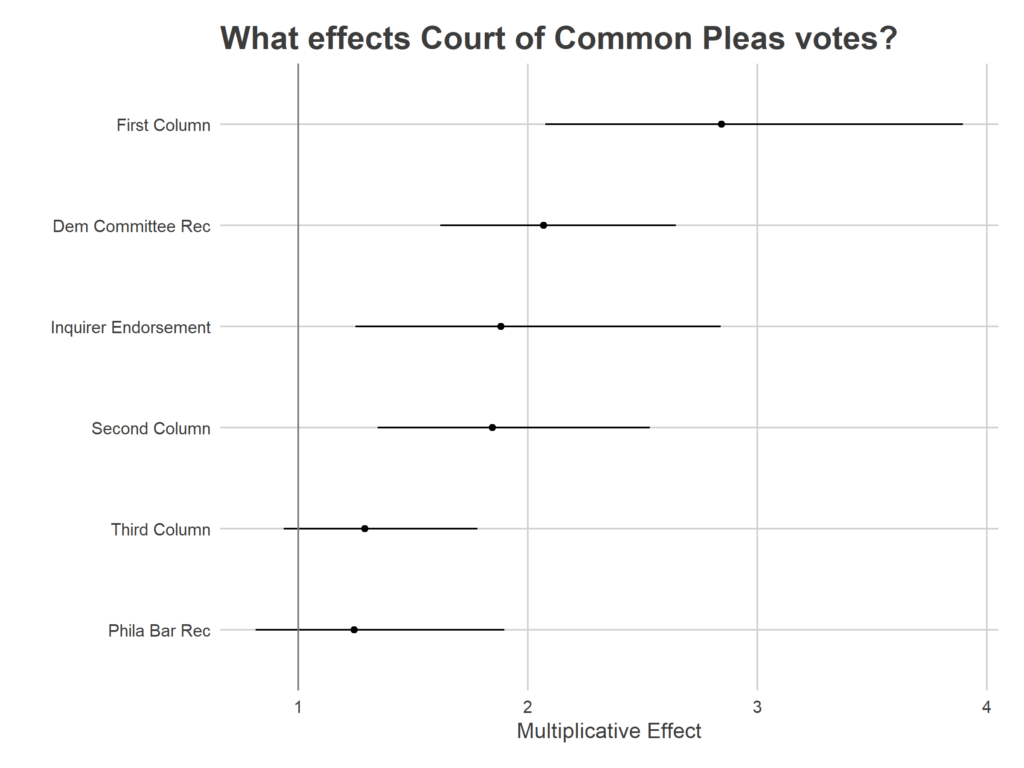
The Philadelphia Bar Association’s correlation is sadly indistinguishable from none at all, but with a *big* caveat: the Philadelphia Inquirer has begun simply adopting the Bar’s recommendations as its own, so that Inquirer correlation represents entirely Recommended candidates.
While this analysis doesn’t include candidate fundraising or Ward endorsements, those certainly matter, and would probably rank high on this list if we had the data. Two years ago, I found tentative evidence that Ward endorsements may matter even more than the first column. And Ward endorsements, in turn, cost money.
There are obvious solutions to this. I personally think holding elections for positions that no-one pays attention to is an invitation for bad results. It’s better to have those positions be appointed by higher profile officials; it concentrates power in fewer hands, but at least the Mayor or Council know that voters are watching.
A more plausible solution than eliminating judicial elections altogether might be to just randomize ballot positions between divisions, rather than use the same ones across the city. That would mean that all candidates would get the first-column benefit in some divisions and not in others, and would wash away its effect, allowing other factors to determine who wins.
Unfortunately, while these are easy in theory, any changes would require a change to the Pennsylvania Election Code, and may be a hard haul. But one thing everyone seems to agree on is that our current system is bad.
I love your work, especially when you write about these judicial elections. Very interesting (and scary)! A couple of questions:
1. Is the impact of non-ballot order factors (e.g., dem committee rec, inquirer endorsement, bar ratings, etc.) generally constant from year to year, or does it vary based on the election (for example, based on the mood of the electorate in a particular year or top of the ballot races)?
2. Have you looked at how candidate name cues affect a race (e.g., female, ethnicity/race, name recognition, etc.)? If so, in what areas do candidate name cues help/hurt more? I would imagine that certain names would be a benefit in some wards, but a hindrance in other wards.
3. It would be very interesting to see how much spending matters, in particular how much it matters when one or more candidates grossly outspend the others.
Keep up the excellent work!
Thanks!
1. This is a really good idea, but I don’t think I have enough data to make those claims. My hunch is that it’s probably consistent; I can’t imagine Common Pleas races ever drawing attention. The one exception is that the Inquirer started copy-pasting the Bar’s Recommendations in 2013 (I think), so their recs probably leaped in importance.
2. In a prior analysis [https://econsultsolutions.com/simulating-the-court-of-common-pleas-election/], I found that women received 23% more votes than men. I haven’t looked at ethnicity or anything else.
3. Spending is going to matter a *ton*. I have dreams of rigorously combing through financial records, but haven’t yet. My hunch is that anyone who wins from column 3 or later spent a medium-sized fortune.
If all judges were to be appointed, it would have to come from Harrisburg. Even though they are located in the city, they are state judges. The governor in fact does apppoint a judge to fill a vacancy on the court due to retirement or death to fill out the rest of the term. Mayor and Council have no say. Needless to say it is a very political process